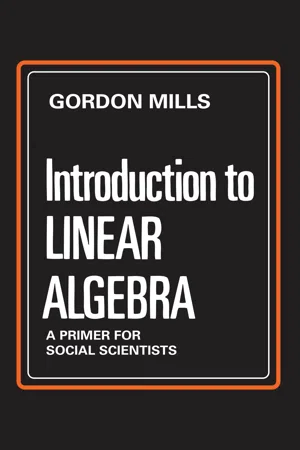Mathematics
Simultaneous Equations
Simultaneous equations are a set of equations with multiple variables that are solved together to find the values of the variables that satisfy all the equations simultaneously. This is typically done using methods like substitution, elimination, or matrices. Solving simultaneous equations allows for finding the intersection point of two lines or the common solution to multiple equations.
Written by Perlego with AI-assistance
Related key terms
Related key terms
1 of 4
Related key terms
1 of 3
8 Key excerpts on "Simultaneous Equations"
- eBook - ePub
- Mike Rosser, Piotr Lis(Authors)
- 2016(Publication Date)
- Routledge(Publisher)
5 Simultaneous linear equations DOI: 10.4324/9781315641713-5Learning objectives
After completing this chapter students should be able to:- Solve sets of simultaneous linear equations with two or more variables using the substitution and row operations methods.
- Relate simultaneous linear equations mathematical solutions to economic analysis, including supply and demand and the basic Keynesian macroeconomic models.
- Construct and use break-even charts.
- Recognize when a linear equations system cannot be solved.
- Derive the reduced form equations for the equilibrium values of dependent variables in basic linear economic models and interpret their meaning.
- Derive the profit maximizing solutions to price discrimination and multiplant monopoly problems involving linear functions.
- Set up linear programming constrained maximization and minimization problems and solve them using the graphical method.
5.1 Systems of Simultaneous Linear Equations
The way to solve single linear equations with one unknown was explained in Chapter 3 . We now turn to sets of linear equations with more than one unknown. A simultaneous linear equation system exists when:- there is more than one functional relationship between a set of specified variables, and
- all the functional relationships are in a linear form.
1the demand schedule isp = 420 − 0.2 q2and the supply schedule isp = 60 + 0.4 qIf this market is in equilibrium then the equilibrium price and quantity will be where the demand and supply schedules intersect. As this will correspond to a point which is on both the demand schedule and the supply schedule then the equilibrium values of p and q - eBook - ePub
- Kenneth M. Shiskowski, Karl Frinkle(Authors)
- 2013(Publication Date)
- Wiley(Publisher)
Chapter 2
Linear Systems of Equations and Matrices
2.1 Linear Systems of Equations
The basic idea behind a general linear system of equations is that of a system of two xy -plane line equations ax + by = c and dx + ey = f , for real constants a through f . Such a system of two-line equations in the xy -plane has a simultaneous solution , the intersection set of the two lines. In general, we consider a simultaneous solution to be the collection of points that simultaneously satisfies all equations in a given system of equations. In the two-line equation system example we have only three possibilities. If the two lines are not parallel, then their intersection set is a single point P; hence the simultaneous solution will simply be {P }. If the two lines are parallel and distinct, then their intersection set is empty and there is no simultaneous solution. Last, if the two lines are the same, the simultaneous solution is simply the entire line, which consists of an infinite number of points. We now give an example of each of these three situations. As you will see, the solution points of each of these three systems are where each pair of lines intersect. In these systems, in order to solve by hand for the solution points, we must try to solve for one of the variables x or y by itself without the other variable. In essence, we are assuming each pair of lines intersect at a single point unless we discover otherwise.Example 2.1.1 . Our first example is to solve the following system:(2.1)In order to solve for one of the variables x or y by itself without the other variable, we can multiply the first equation by 3 and multiply the second equation by 2, which makes the coefficients of y negatives of each other. Now, we can add the two equations together eliminating the variable y , and so solving for x . Similarly, we can solve for y - eBook - ePub
Introduction to Linear Algebra
A Primer for Social Scientists
- Gordon Mills(Author)
- 2017(Publication Date)
- Routledge(Publisher)
CHAPTER 6The solution of simultaneous linear equations6.1 Introduction
One of the most Important and most common types of calculation in linear algebra is the solution of a system of simultaneous linear equations. We have already had occasion (in section 3.11 for example) to write out a general system of m equations involving n variables denoted x j for j = 1, …., n ; such a system may be written out in full:a 11x 1+a 12x 2+ … . +a1 nx n=b 1a 21x 1+a 22x 2+ … . +a2 nx n=b 2. ⋮am 1x 1+am 2x 2+ … . +am nx n=b mIf the vectors x and b and the matrix A are defined in the obvious way, then the system can be written :Ax = bIn this chapter, we shall be concerned with whether or not such a system has a solution in any particular case, and (above all) with the computation necessary to find a solution.By ‘a solution’ we mean a set of numerical values, one for each of the variables, such that each of the equations is satisfied by this set of values. It is for this reason that we speak of a system of simultaneous equations – one and the same set of values must simultaneously satisfy every equation in the system. As pointed out in section 1.1 , an applied context may require the variables to be confined to non-negative values, and may even rule out all but integer values. In this chapter, it is supposed that the analysis may be conducted in terms of continuous variables (and that If necessary in an applied context, any fractional values may be rounded off at the end of the calculation). As far as the mathematical analysis is concerned, It is also supposed that in a solution to a system of equations, the variables may take on any values, positive or negative, Integer or fractional ; this is the supposition under which we will ascertain whether or not a system of equations has a solution. In applying this analysis to particular contexts, It will sometimes be necessary to rule out negative values; and even if a solution exists in the sense previously Indicated, It does not necessarily follow that a non-negative solution exists. (The circumstances In which it is necessary to conduct the analysis In terms of integer variables right from the outset will be discussed briefly in Chapter 7 - eBook - ePub
- Paul Turner, Justine Wood(Authors)
- 2023(Publication Date)
- Mercury Learning and Information(Publisher)
3SIMULTANEOUS EQUATIONSEconomic and business analysis frequently requires us to seek the solution of systems of Simultaneous Equations. For example, the analysis of markets involves the solution of demand and supply systems for the equilibrium price and quantity values. In macroeconomic analysis, the Keynesian model of output determination is written as a simultaneous system of equations in output, consumption, and autonomous expenditures, which we solve to find an equilibrium. This chapter explores the mathematics of systems like the Keynesian model. Our aim is to determine the conditions necessary for a solution to exist and to find methods through which we can systematically find the solution.3.1 LINEAR EQUATIONSSystems of linear equations are relatively simple to solve. In this section, we look at the properties of linear equations and show how they can be transformed into forms which make finding solutions easy.A linear equation is a first-order polynomial function. The general form of such a relationship is given in equation,(3.1)where y and x are variables which we will assume are real numbers. The symbols a and b represent parameters. That is, they are general symbols for numbers which are fixed for any given equation but can be varied for the purposes of analyzing different equations. The parameter a is the intercept , that is, the value of y at which the graph of the function crosses the vertical axis when the line is drawn in the Cartesian place. The parameter b is the slope or gradient of the line. This gives this ratio of the change in y divided by the change in x for a given interval on the line. The gradient of a linear equation is constant for any interval. This form of the equation is known as the explicit form because the dependent variable , y , is written explicitly in terms of the independent variable , x . A linear equation can be interpreted as a function which maps the set of real numbers to itself. This is true because the relationship is defined for every value of x in the set of real numbers, and, providing - eBook - ePub
- Hans Schneider, George Phillip Barker(Authors)
- 2012(Publication Date)
- Dover Publications(Publisher)
2Linear Equations1. EQUIVALENT SYSTEMS OF EQUATIONSLinear equations were introduced in Chapter 1 . In this chapter we shall obtain a systematic method for solving any system of m linear equations in n unknowns. Our analysis will also give the number and type of possible solutions. We begin by studying some simple examples for which the solutions can be readily found. Consider the equationsFirst we add the two equations together; then we subtract the second equation above from twice the first to obtain the systemTherefore the unique solution of the system (2.1.1 ) is x1 = 2 and x2 = −1. Writing the equations in matrix vector form, Ax = b, whereWe have shown that the unique solution isSuppose we look at another system of equations and the associated matrix form Ax = b:Clearly there are infinitely many solutions of the system (2.1.2 ), since any solution of 2x1 + 2x2 = 2 is a solution of x1 + x2 = 1 and conversely. We may therefore choose values for one of the unknowns arbitrarily. Thus any vector of the formis a solution, and any solution is of this form. Let us consider a third example:If we multiply the first equation of (2.1.3 ) by 2, we have 2x1 + 2x2 = 2. Thus there can be no solution.Using some elementary analytic geometry, we can interpret these Simultaneous Equations quite easily. Thus, the equation (2.1.1 ) represents two lines in the (x1 , x2 ) plane and the solution x1 = 2, x2 = 1 is the coordinates of the unique point of intersection of these lines. In the case of (2.1.2 ), both equations represent the same line. Hence, any point on this line represents a solution. Finally, in (2.1.3 ) we have two parallel lines; therefore, there is no point of intersection and so no solution to the equations.Before we proceed it is necessary to introduce some new terminology. We shall again assume that all coefficients lie in , where - eBook - ePub
- Toby Wagner(Author)
- 2021(Publication Date)
- Chemeketa Press(Publisher)
Chapter 2 , we learned that a linear equation in two variables has infinitely many solutions. In other words, there are infinitely many combinations of variable values (ordered pairs) that will make the equation true. When graphed, all of the solutions make a straight line.If we need to find a particular solution, then we must be given more than one equation.Here is a problem like that:This problem may seem confusing and raise a lot of questions: Exactly what does “solve” mean in this case? How can we solve more than one equation at a time? How can we solve anything by graphing? Before tackling this problem, we need to understand systems of equations and revise our definition of the word “solution.”After completing this section, you should be able to: ◆ Recognize a system of equations and a solution for a system of equations ◆ Graphically interpret systems with one solution, no solution, or infinitely many solutions ◆ Solve a system of linear equations graphically — by hand and with a graphing calculatorA. Solution of a System
A set of two linear equations using two variables is called a system of linear equations in two variables. For short, we can call it a system of equations. For example, this pair of equations is a system of equations:The big, curvy grouping symbol to the left of the equations is called a brace, and it’s used to show that the two equations occur together and at the same time.Before we move forward, let’s remember a couple of things from Chapter 2 :◆ We know that an ordered pair is a set of two numbers that are written in a particular order. They are written in parentheses, like this: (2, 7). In this case, the first number, 2, represents the x - eBook - ePub
- James R. Kirkwood, Bessie H. Kirkwood(Authors)
- 2020(Publication Date)
- Chapman and Hall/CRC(Publisher)
2Systems of Linear Equations
In this chapter we discuss finding the solution of a system of linear equations. While this is an important topic in itself, the techniques we learn here will carry over to many other types of problems.Historical Note
Seki Takakazu , also called Seki Kōwa , (born c. 1640, died 1708), was the most important figure of the wasan (“Japanese calculation”) tradition thatflourished from the early seventeenth century until the opening of Japan to the West in the mid-nineteenth century. He was instrumental in recovering mathematical knowledge from ancient Chinese sources and then extending and generalizing the main results.Seki anticipated several of the discoveries of Western mathematics and was the first person to study determinants in 1683. Ten years later, Leibniz independently used determinants to solve Simultaneous Equations, although Seki’s version was the more general.He developed a theory of determinants that predated work by the eighteenth-century German mathematician, Gottfried Leibniz.Seki’s discovery, around 1680, of a general theory of elimination – a method of solving Simultaneous Equations by reducing the number of variables one by one – wasn’t matched until more than a century later, by Étienne Bézout (1730–1783).Section 2.1 Basic Definitions
Definition:A linear equation in the variablesis an expression of the formx 1, … ,x na 1x 1+ ⋯ +a nx n= bwhereA solution to the equationand b are constants.a 1, … ,a na 1x 1+ ⋯ +a nx n= bis an ordered n -tuple of numbersfor which()s 1, … ,s n
The solution set to the equationa 1s 1+ ⋯ +a ns n= b .
is the set of all solutions to the equation.a 1x 1+ ⋯ +a nx n= bA system of linear equations in the variablesx 1, … ,x n - eBook - ePub
Numerical Methods in Engineering and Science
(C, C++, and MATLAB)
- B. S. Grewal(Author)
- 2018(Publication Date)
- Mercury Learning and Information(Publisher)
3 Solution of SimultaneousAlgebraic Equations Chapter Objectives- Introduction to determinants
- Introduction to matrices
- Solution of linear Simultaneous Equations
- Direct methods of solution: Cramer’s rule, Matrix inversion method, Gauss elimination method, Gauss-Jordan method, Factorization method
- Iterative methods of solution: Jacobi’s method, Gauss-Seidal method, Relaxation method
- Ill-conditioned equations
- Comparison of various methods
- Solution of non-linear Simultaneous Equations—Newton-Raphson method
- Objective type of questions
3.1 Introduction t to Determinants1. Definition. The expression is called a determinant of the second order and stands for ‘a1 b2 – a2 b1 ’. It contains four numbers a1 , b1 , a2 , b2 (called elements) which are arranged along two horizontal lines (called rows) and two vertical lines (called columns).is called a determinant of the third order. It consists of nine elements which are arranged in three rows and three columns.In general, a determinant of the nth order is of the formwhich is a block of n2 elements in the form of a square along n rows and n columns. The diagonal through the left- hand top corner which contains the elements a11 , a22 , a33 , …, ann is called the leading diagonal.Expansion of a determinant. The cofactor of an element in a determinant is the determinant obtained by deleting the row and the column which intersect at that element, with the proper sign. The sign of an element in the ith row and jth column is (–1)i+j
Index pages curate the most relevant extracts from our library of academic textbooks. They’ve been created using an in-house natural language model (NLM), each adding context and meaning to key research topics.
Explore more topic indexes
Explore more topic indexes
1 of 6
Explore more topic indexes
1 of 4







